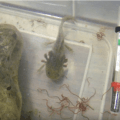Table of Contents
A great axolotl freshwater includes maintaining a great water condition. It will greatly concern your axolotl’s health, longevity, as well as his well-being. In creating a new tank, you need to go through cycling to properly process your aquarium. You need to do this before you put the animals inside the tank. Your axolotl freshwater pet will surely stay healthy if you give them the correct temperature. The tank needs to have stable 15 to 23 degrees Celsius in temperature. Your freshwater axolotl could very much get distressed if the tank exceeds the temperature of 24 degrees Celsius. Your pet could not stand hot places. If your pet is exposed to these kinds of things, it could cause reactions such as loss of appetite, death, and fungal infection.
Your axolotl’s freshwater health could be greatly affected if there is high water temperature. The ammonia toxicity will also rise in the water – this is not only dangerous but also harmful for the axolotls. However, if the temperature is too cold, your freshwater axolotl’s health would begin to slow down. Because if they get too cold, it will make them unwell as well as sluggish. In this essence, you need to keep your tank temperature within the appropriate range. It sometimes is impossible to maintain the right temperature year-round, however, you can use aquarium chillers to cool down the waters. This article would help you set up the right temperature for your right tank to maintain the correct acidity and correct current.
Axolotl Freshwater: The Right Flow
Your axolotl needs to have a stable water condition to promote the needed health. Unlike other fishes, your freshwater axolotls can’t tolerate other distinct water flow. If they live in this condition, you can see that they have a loss of appetite which would lead to stress then would end up in illnesses. Although it is very essential that you have filtration systems, you still need to monitor these things because these things could even disturb the water flow! Spray bars or any flow-spreading outlet could minimize the disturbance. You can see that your pet is distress when you see their gills turned forward and they have a great appetite loss. From this, you need to adjust the flow of the water in your tank because it means it has a disturbance such as being too high.
Axolotl Freshwater: The Right pH Level
Your freshwater axolotls also need a correct pH level in terms of basicity as well as acidity. The correct pH level for your pet is around 6.5 to 8.0, however, you should aim to have the desired level of 7.40 up to 7.60 – this level is the optimum key to make them healthy. Aside from having this pH level, it is also needed that you keep these stable because if there is a slight change in the pH level, it could potentially affect the ammonia toxicity in the water – it would eventually lead to ammonia poisoning. An easy way to adjust the pH level of your water is using salts, it could change its acidity or toxicity. There are also pH-changing kits that are easily available at your aquatic retailers.
Axolotl Freshwater: Chlorine and Chloramines
Another thing that could seriously harm your fish, amphibians, and even humans are the chlorine, this is also the reason why swimming pools are blue in color. Chlorine is known to kill bacteria in water supplies before the water reaches the public.
As we have pointed out earlier, ammonia is another toxic thing for your axolotl freshwater pet. If an unfortunate event, you combine chlorine with ammonia – this would form a product we call chloramines. To prevent this from happening, you should have a de-chlorinator whenever you clean and put water in your aquarium. This chemical would remove chloramines and chlorine and other harmful things such as lead and mercury from the water.
You always need to use a de-chlorinator whenever you are changing the water inside the aquarium. If you do not know if all the harmful substances have already been removed, you can use chlorine testing kits to double check.
Axolotl Freshwater: Ammonia, Nitrite, and Nitrate
Your freshwater axolotls, as well as other aquatic animals, have ammonia as their waste product. Unfortunately, these are very toxic, especially in their unionized form. In this scenario, you need to find the correct pH for the aquarium for your axolotl freshwater. To keep ammonia in the unionized form, you need to have a high pH level. You can do it at pH 8 or even more. If you do not achieve this, the ammonia could kill your pet very quickly.
To maintain the safeness of your axolotl freshwater you need to do a routine ammonia test, this is to supervise the increase of ammonia and its toxicity. There are several ammonia test kits from different aquatic retailers. You do this task every now and again to make sure that your aquarium is still safe for your pet.
You should always have a test kit ready for your nitrite. Nitrite is a product of ammonia, although it is not as toxic as the latter, it is still better to be safe than sorry. You might think that low-level nitrate is not really toxic, however, if you let it build up, it could be very dangerous – and it could even lead to algae accumulation. You need to have regular water changes to ensure that nitrates contents are in check. Although it is still best that you check the nitrate’s content periodically.
Axolotl Freshwater: Water Hardness and Dissolved Salts
Aside from ammonia, there is still another thing that you need to look for to fully take care of your freshwater axolotl. The amount of dissolved water in a selected body of water can be termed as “water hardness”. Limescale envelops both the kettles and pipes of those houses with “hard water areas”. Calcium and magnesium salt deposition is actually the two components contributing to limescale. However, those houses that are erected in soft water areas would not have the same issue. The chemical balance in the aquarium can be seriously affected by the salt. A rule of thumb: hard water would make the water alkaline or basic, while soft water would increase the acidity.
Hard water situations are the best place for you to keep you axolotl freshwater pet. If you see gill discoloration as well as pale pigmentation, it might give rise to a temporary case of anemia. Temporary anemia is not really harmful, however, it gives a bad sign for the condition of your tank. Adding salts in the water of the aquarium could increase water hardness. This technique is one way to solve the water hardness for your pet.
How Many Axolotl Freshwater Pets in One Tank?
You should not really house your axolotl freshwater with other salamanders or fish. Some salamanders, as well as other fishes, might find your freshwater axolotls good-looking. This could cause them to nibble away the gills when they have a chance. Newts and salamanders are the common culprits for this case, especially during the feeding time, so you need to isolate your pet from other sea creatures.
Some of you might think that larger axolotls wouldn’t face this issue because smaller fish wouldn’t dare attack a salamander that is much bigger than they are correct? Well, it’s partly true but there’s a catch, if you house freshwater axolotls with smaller fish, it will most likely lead to their demise. The reason for that is because axolotls are known to eat pretty much anything that fits in their mouths and that includes small fishes, shrimps, and even other smaller freshwater axolotls!
You should not really keep your baby axolotls freshwater same reason as the above-mentioned reasons. They might nip other amphibians and it could seriously damage the health. Adult freshwater axolotls have a harmonious relationship with one another and they may not really attack each other. However, wild-type axolotl has the habit of nipping. For all of these, it is still best that you monitor them.






 Author and long-time animal lover. Sharing knowledge on pet care through experience and the written word.
Author and long-time animal lover. Sharing knowledge on pet care through experience and the written word.